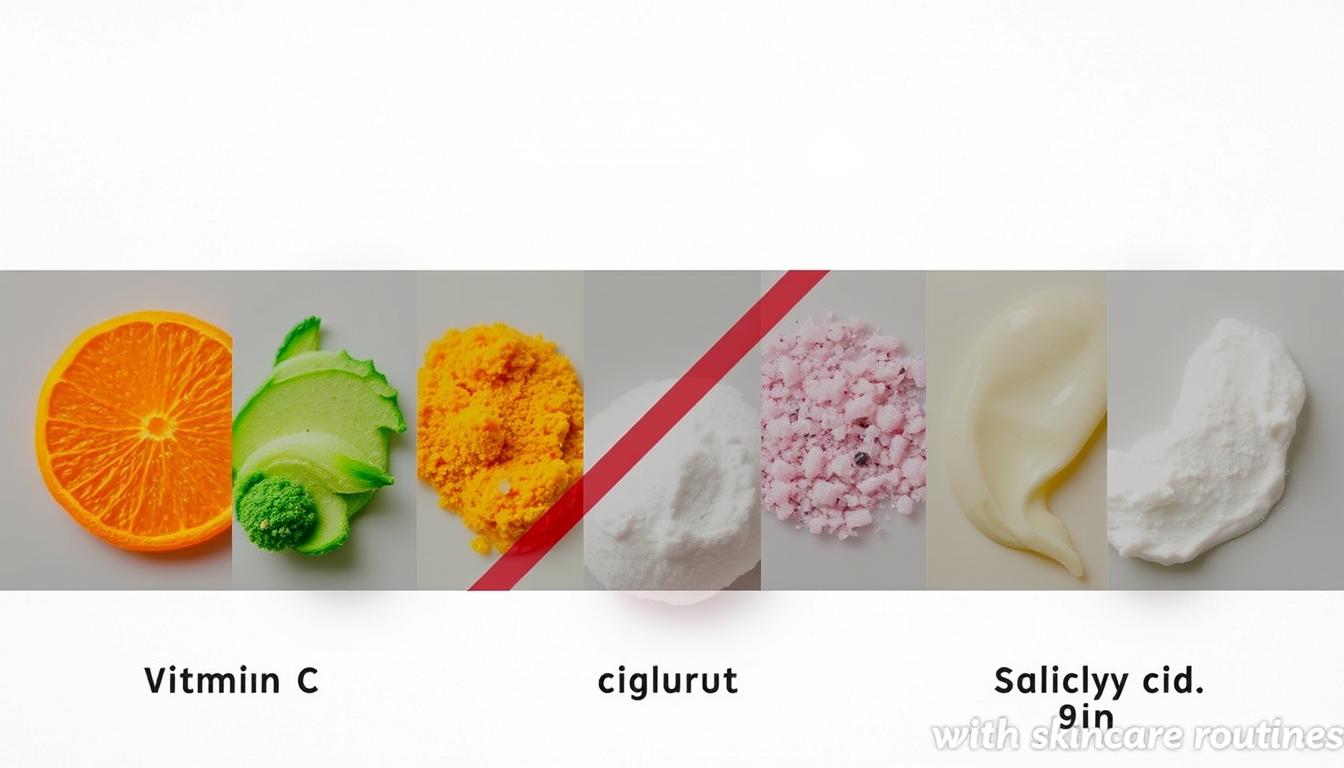I’m excited to share my knowledge about skin care ingredients. It’s important to know which ones go well together. In this article, we’ll look at 6 combinations that don’t mix well and how to avoid them.
Understanding how different ingredients interact is key. This knowledge helps you avoid skin irritation and damage. The right skincare tips can lead to healthy and glowing skin.
We’ll explore the world of skincare ingredients together. We’ll see how certain combinations can affect your skin. By learning about these 6 combinations and following skincare tips, you can create a routine that works for you.
Understanding the Science Behind Skincare Ingredient Interactions
Before we explore which ingredients to avoid, let’s understand how they interact. Knowing this helps create a skincare routine that meets your skin’s needs.
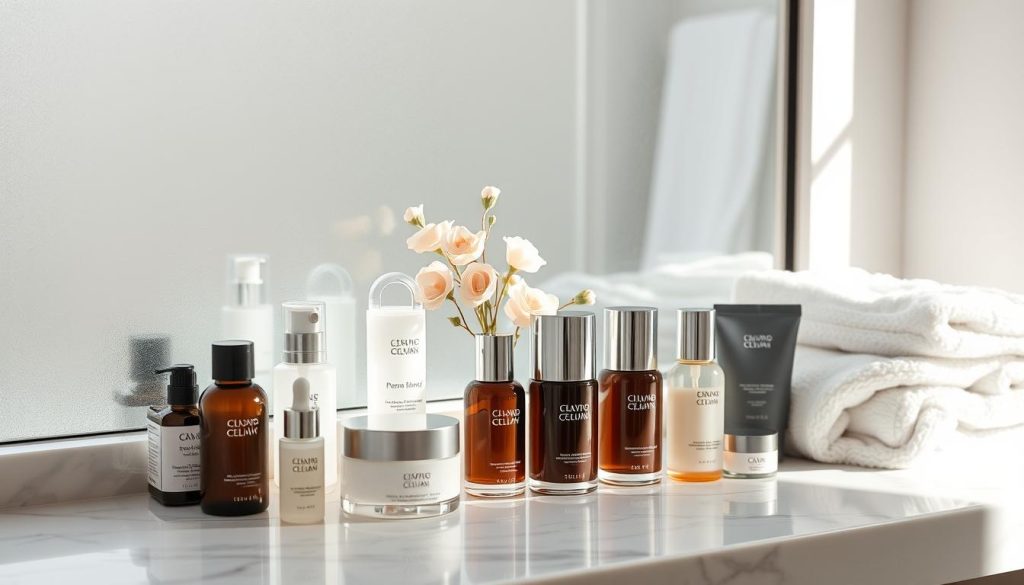
How Active Ingredients Work Together
Active ingredients can either work well together or not at all. For example, vitamin C and ferulic acid together boost antioxidant protection. This makes your skincare routine more effective.
The Role of pH Levels in Skincare
The pH level of a product is crucial. It affects how active ingredients work. Products like CeraVe cleanser have a balanced pH. This supports the stability of other skincare products, ensuring your routine works well.
Why Some Ingredients Don’t Play Nice
Certain ingredients can cancel out each other’s benefits. For instance, using benzoyl peroxide and vitamin C together can reduce their effectiveness. This disrupts your skincare routine.
6 Skin-Care Ingredient Combinations That Don’t Mix
Building a good skincare routine means knowing which ingredients don’t go together. Mixing the wrong products can cause irritation, make your skin less effective, or even harm it. Here are six skincare ingredients to avoid pairing together:
- Retinol and Vitamin C: These can dry out your skin too much and cause irritation.
- AHAs and BHAs: Using both can strip your skin of its natural barrier.
- Benzoyl Peroxide and Retinol: This mix can make retinol less effective.
- Niacinamide and Vitamin C: They can cancel each other out, reducing their benefits.
- Salicylic Acid and Benzoyl Peroxide: This combination may be too harsh, causing redness and peeling.
- Hydroquinone and Retinol: Together, they can increase skin sensitivity and irritation.
Knowing which ingredients don’t mix is crucial for healthy, happy skin. By avoiding these pairings, each product in your routine can work well without causing problems.
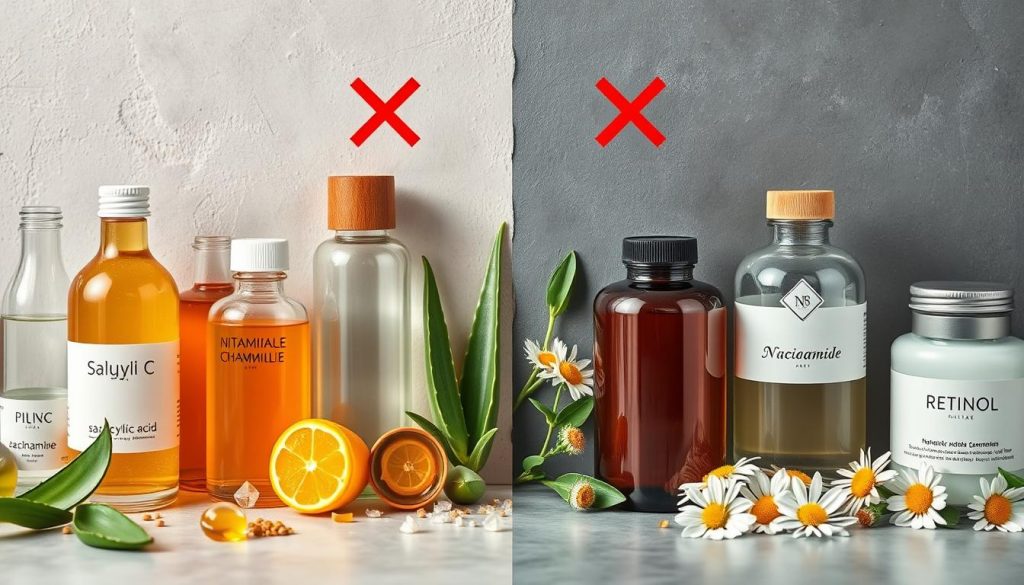
| Ingredient Combination | Potential Issues |
|---|---|
| Retinol and Vitamin C | Dryness and irritation |
| AHAs and BHAs | Over-exfoliation and compromised skin barrier |
| Benzoyl Peroxide and Retinol | Reduced effectiveness of retinol |
| Niacinamide and Vitamin C | Cancellation of benefits |
| Salicylic Acid and Benzoyl Peroxide | Redness and peeling |
| Hydroquinone and Retinol | Increased skin sensitivity and irritation |
Retinol and Vitamin C: A Problematic Partnership
Using retinol and vitamin C in your skincare routine can be good. But, they often don’t mix well. Knowing why is key for good skincare tips.
Why These Powerhouse Ingredients Clash
Retinol needs a higher pH to work well, while vitamin C prefers a more acidic environment. This difference can cause problems. It might make both ingredients less effective and even irritate your skin.
Alternative Ways to Use Both
To use both retinol and vitamin C effectively, apply them at different times. Use vitamin C in the morning for its antioxidant benefits. Save retinol for your evening routine to help your skin renew overnight.
Best Time of Day for Each
Vitamin C is best in the morning to shield your skin from daily stressors. Retinol, being stronger and possibly irritating, is better at night. This way, your skin can heal and grow without sunlight.
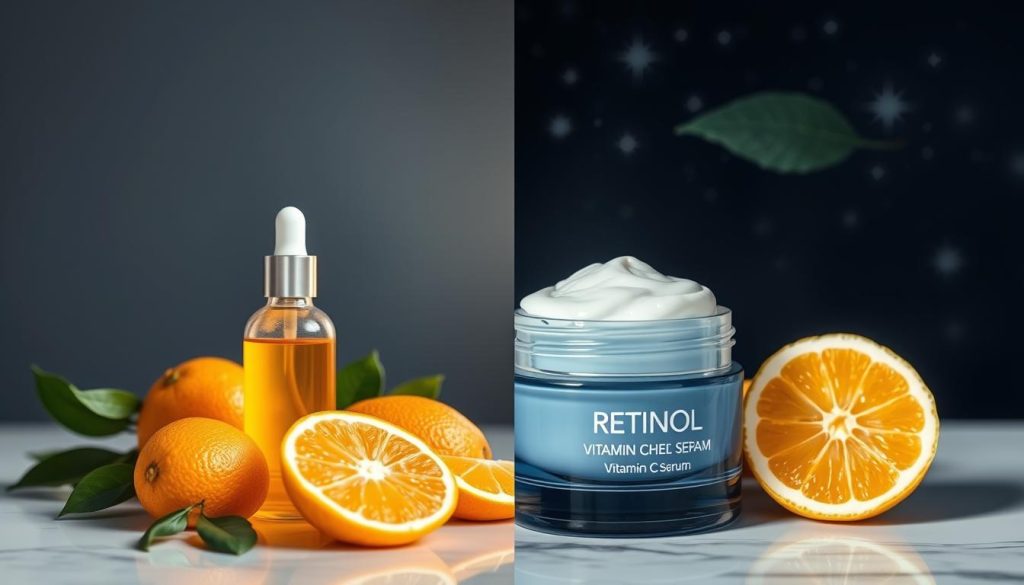
The Dangers of Mixing AHAs and BHAs Together
Choosing the right skin care ingredients is key to a good routine. AHAs and BHAs are great for exfoliating and keeping skin smooth. But mixing them can be bad.
Using AHAs and BHAs together can lead to too much exfoliation. This can make your skin feel sore and sensitive. It’s crucial to avoid this to keep your skin healthy.
Here are some skincare tips for safe use of AHAs and BHAs:
- Use AHAs in the morning and BHAs in the evening.
- Alternate days for each ingredient.
- Watch how your skin reacts and adjust as needed.
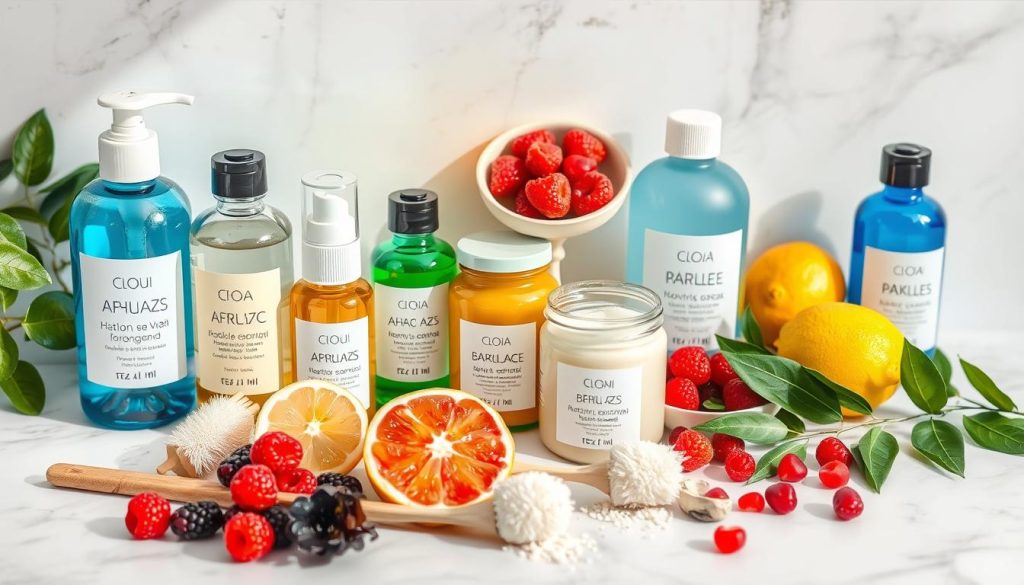
| Ingredient | Best Time to Use | Benefits |
|---|---|---|
| AHAs | Morning | Brightens skin, improves texture |
| BHAs | Evening | Unclogs pores, reduces acne |
Benzoyl Peroxide and Vitamin C: The Oxidation Issue
Using benzoyl peroxide and Vitamin C together can cause problems. These two strong ingredients can cancel each other out. This makes it harder to reach your skincare goals.
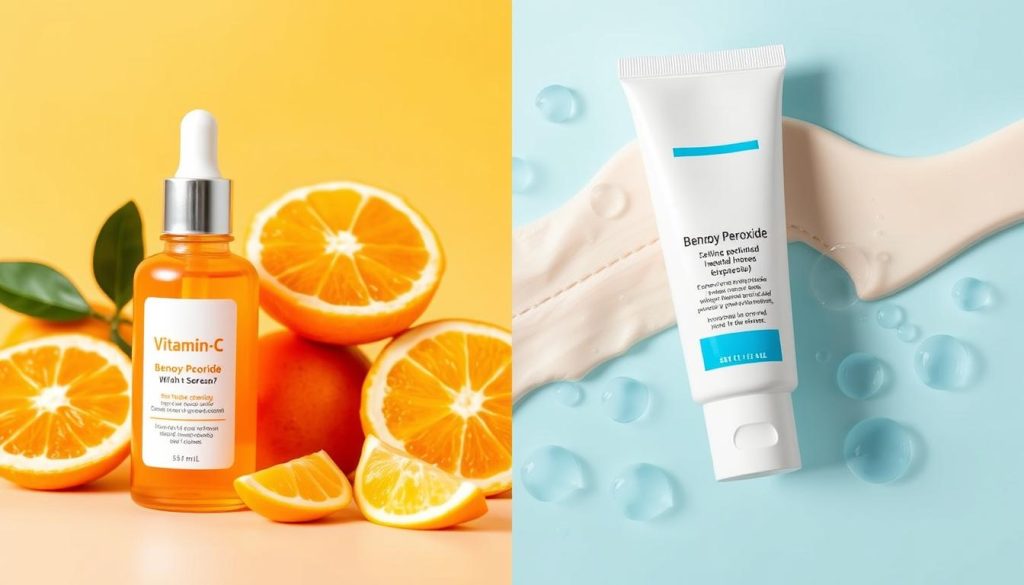
Chemical Reaction Explanation
Benzoyl peroxide works by oxidizing things, while Vitamin C does the opposite. When they’re together, benzoyl peroxide can damage Vitamin C. This makes Vitamin C less good at brightening your skin and fighting off free radicals.
At the same time, benzoyl peroxide doesn’t work as well against acne. This is because Vitamin C is needed to help benzoyl peroxide work right.
Product Recommendations for Separate Use
To get the most out of both ingredients, use them at different times. Here are some products to consider:
| Product Type | Recommended Product | Usage Time |
|---|---|---|
| Vitamin C Serum | SkinCeuticals C E Ferulic | Morning |
| Benzoyl Peroxide Treatment | PanOxyl Acne Foaming Wash | Evening |
Using them separately lets each ingredient do its job best. This way, you get the best results for your skin without losing their benefits.
For more skincare tips, always talk to a dermatologist. They can help create a routine that’s just right for you.
Niacinamide and Vitamin C: Separating Fact from Fiction
Many people wonder if niacinamide and Vitamin C can be used together in skincare. Some believe they cancel each other out. But, recent studies show this isn’t always true. Knowing the science behind these ingredients is key to a good beauty routine.
Niacinamide and Vitamin C both have great benefits. Niacinamide improves skin texture and reduces redness. Vitamin C brightens your skin and fights free radicals. When used right, they work well together.
Here are some tips for mixing skincare:
- Layering: Use Vitamin C in the morning to protect against damage. Apply niacinamide at night to repair and nourish.
- Wait Time: If using them together, apply Vitamin C first. Let it absorb for a few minutes before adding niacinamide.
- Formulations: Pick products with stable forms of Vitamin C and niacinamide for better compatibility.
By carefully adding both ingredients, you can boost your beauty routine. Try different methods to see what’s best for your skin.
The Truth About Mixing Exfoliants with Other Active Ingredients
Exfoliants are great for refreshing your skin. But, mixing them with some actives can cause irritation or make them less effective. It’s important to know which ones to use together and which to avoid for healthy skin.
Common Exfoliant Combinations to Avoid
Mixing exfoliants with other strong actives can upset your skin’s balance. Here are some combinations to avoid:
- Retinol and AHAs/BHAs: This mix can overstimulate the skin, causing redness and peeling.
- Vitamin C and Benzoyl Peroxide: These ingredients can neutralize each other, reducing their benefits.
- Salicylic Acid and Niacinamide: Potential for irritation when used together excessively.
Safe Exfoliation Practices
To use exfoliants without harming your skincare routine, follow these tips:
- Alternate Days: Use exfoliants on different days than other potent actives.
- Patch Test: Always test new combinations on a small skin area first.
- Listen to Your Skin: If irritation occurs, reduce frequency or adjust the products used.
Being careful about which skincare ingredients to avoid helps keep your routine balanced and effective. These tips will guide you through the complex world of active ingredients safely.
Creating a Safe and Effective Skincare Routine
Creating a skincare routine that fits your needs keeps your skin healthy and glowing. Knowing which ingredients to use and when helps you make a beauty regimen that works well without harming your skin.
Morning Routine Guidelines
Begin your day with products that protect and wake up your skin. Start with a gentle cleanser to wash away overnight dirt. Then, apply a vitamin C serum to brighten your skin and fight off environmental stress.
Next, use a moisturizer to keep your skin hydrated. Finish with a broad-spectrum sunscreen to protect against UV rays. This morning skincare routine helps you start the day with a radiant glow.
Evening Routine Recommendations
In the evening, focus on repairing and nourishing your skin. Cleanse well to remove makeup and pollutants from the day. Use a retinol serum to help your skin renew itself and reduce aging signs.
Apply a rich moisturizer to keep your skin hydrated and support its natural healing. Following this beauty regimen keeps your skin looking vibrant and refreshed.
How to Layer Products Correctly
Getting the most out of your skincare routine starts with mixing products right. Knowing the correct order for your skincare products is key to their success.
Here are some tips to layer your products correctly:
- Cleanser: Start with a gentle cleanser to clean off dirt and oil.
- Toner: Use a toner to balance your skin’s pH levels.
- Serums: Apply lightweight serums with active ingredients like Vitamin C or hyaluronic acid.
- Moisturizer: Seal in the benefits with a hydrating moisturizer.
- Sun Protection: Finish with sunscreen during the day to protect your skin.
Remember, less is more in skincare. Start with thin, water-based products and add thicker creams on top. This way, each product works well without getting in the way of others.
By following these simple tips, you can make a skincare routine that boosts your skin’s health and looks. Take the time to learn about each product and how it fits into your routine for the best results.
Signs Your Products Aren’t Working Well Together
Sometimes, my favorite products don’t mix well. Spotting the signs early can prevent skin stress.
Physical Signs of Negative Reactions
- Redness: Unexplained redness can mean irritation from bad skin care mixes.
- Dryness or Peeling: Too much dryness might come from using too many strong products together.
- Breakouts: New or more breakouts could mean harmful mixes upsetting your skin’s balance.
- Sensitivity: Feeling more sensitive or a burning feeling after using products.
When to See a Dermatologist
If you see ongoing irritation or serious reactions, get expert advice. A dermatologist can figure out the problem ingredients. They’ll suggest the best way to fix your skin’s health.
Conclusion: Building Your Perfect Skincare Combination
Starting a good skincare routine means knowing which ingredients go together well. By avoiding bad combinations, you can avoid skin problems and make your routine better.
Always check the labels and look up the ingredients in your products. This careful planning helps your skincare work together, making your skin healthier and brighter.
Creating a skincare plan that fits your skin’s needs is key. Try different mixes that match your skin type and goals. If you need help, talk to a dermatologist for advice.
Now you know how to create a skincare routine that avoids bad mixes and gets the most out of each product. Get ready for the glowing skin you’ve always wanted!
